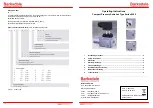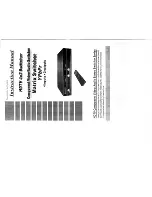
Display IGMP Snooping Information
The following example shows how to display the
snooping groups:
console#show mac-address-table igmpsnoopingVLAN ID MAC Address Type
Description Interfaces
------- ----------------- ------- ---------------- --------------
1 01:00:5E:01:02:03 Dynamic Network Assist Fwd: 1/0/2
Configuring Static Multicast Forwarding Entries
The following example shows how to create a static multicast forwarding entry for VLAN 1 and multicast
MAC address 01:00:5E:11:22:33, associate it with the destination port 1/0/2 and the source port 1/0/4.
(Extreme 220)(config)#macfilter 01:00:5e:11:22:33 1
(Extreme 220)#interface 1/0/2
(Extreme 220)(Interface 1/0/2)#macfilter adddest 01:00:5e:11:22:33 1
(Extreme 220)(Interface 1/0/2)#exit
(Extreme 220)#interface 1/0/4
(Extreme 220)(Interface 1/0/4)#macfilter addsrc 01:00:5e:11:22:33 1
(Extreme 220)(Interface 1/0/4)#exit
(Extreme 220)#show mac-address-table multicast
Fwd
VLAN ID MAC Address Source Type Description Interface Interface
------- ----------------- ------- ------- --------------- --------- ---------
1 01:00:5E:11:22:33 Filter Static Mgmt Config Fwd: Fwd:
1/0/2 1/0/2
(Extreme 220)#show mac-address-table static all
Source Destination
MAC Address VLAN ID Port(s) Port(s)
----------------- ------- ------------------- -------------------
01:00:5E:11:22:33 1 1/0/4 1/0/2
(Extreme 220)#show mac-address-table multicast 01:00:5e:11:22:33 1
Fwd
VLAN ID MAC Address Source Type Description Interface Interface
------- ----------------- ------- ------- --------------- --------- ---------
1 01:00:5E:11:22:33 Filter Static Mgmt Config Fwd: Fwd:
1/0/2 1/0/2
Configuring Port Mirroring
Port mirroring is used to monitor the network traffic that a port sends and receives. The Port Mirroring
feature creates a copy of the traffic that the source port handles and sends it to a destination port. The
source port is the port that is being monitored. The destination port is monitoring the source port. The
destination port is where you would connect a network protocol analyzer to learn more about the traffic
that is handled by the source port.
A port monitoring session includes one or more source ports that mirror traffic to a single destination
port. 200 Series software supports a single port monitoring session. LAGs (port channels) cannot be
used as the source or destination ports.
For each source port, you can specify whether to mirror ingress traffic (traffic the port receives, or RX),
egress traffic (traffic the port sends, or TX), or both ingress and egress traffic.
The packet that is copied to the destination port is in the same format as the original packet on the wire.
This means that if the mirror is copying a received packet, the copied packet is VLAN tagged or
Configuration Examples
ExtremeSwitching 200 Series: Administration Guide
350
















































